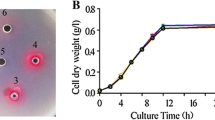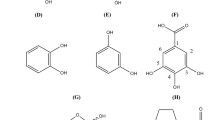Abstract
In bacteria, quorum sensing (QS) is a process of chemical communication involving the production, release, and subsequent detection of signaling molecules. QS regulates the production of key virulence factors in pathogens. During the screening of herbal extracts, clove extract was found to inhibit QS-controlled gene expression in Pseudomonas aeruginosa QSIS-lasI and Chromobacterium violaceum CV026 biosensors. Using a bioautographic TLC assay, preparative TLC, and HPLC analysis, eugenol, the major constituent of clove extract, exhibited QS inhibitory activity. Eugenol at sub-inhibitory concentrations inhibited the production of virulence factors, including violacein, elastase, pyocyanin, and biofilm formation. Using two Escherichia coli biosensors, MG4/pKDT17 and pEAL08-2, we confirmed that eugenol inhibited the las and pqs QS systems. Our data identified eugenol as a novel QS inhibitor.
Purpose of the work
The purpose of this study was to track the quorum sensing inhibitor (QSI) in herbal extracts by effective screening systems and evaluate its biological activity. The QSIs from herbal extracts are potential agents for the treatment of bacterial infections.






Similar content being viewed by others
References
Blosser RS, Gray KM (2000) Extraction of violacein from Chromobacterium violaceum provides a new quantitative bioassay for N-acyl homoserine lactone autoinducers. J Microbiol Methods 40:47–55
Cugini C, Calfee MW, Farrow JM III et al (2007) Farnesol, a common sesquiterpene, inhibits PQS production in Pseudomonas aeruginosa. Mol Microbiol 65:896–906
Dekimpe V, Deziel E (2009) Revisiting the quorum-sensing hierarchy in Pseudomonas aeruginosa: the transcriptional regulator RhlR regulates LasR-specific factors. Microbiology 155:712–723
Fuqua C, Parsek MR, Greenberg EP (2001) Regulation of gene expression by cell-to-cell communication: acyl-homoserine lactone quorum sensing. Annu Rev Genet 35:439–468
Jakobsen TH, Bragason SK, Phipps RK et al (2012) Food as a source for quorum sensing inhibitors: iberin from horseradish revealed as a quorum sensing inhibitor of Pseudomonas aeruginosa. Appl Environ Microbiol 78:2410–2421
Khan MS, Zahin M, Hasan S et al (2009) Inhibition of quorum sensing regulated bacterial functions by plant essential oils with special reference to clove oil. Lett Appl Microbiol 49:354–360
McLean RJ, Pierson LS III, Fuqua C (2004) A simple screening protocol for the identification of quorum signal antagonists. J Microbiol Methods 58:351–360
National Committee for Clinical Laboratory Standards (2003) Methods for Dilution Antimicrobial Susceptibility Tests for Bacteria That Grow Aerobically; Approved Standard, 6th edition. M7–A6. NCCLS, Wayne PA
Pearson JP, Gray KM, Passador L et al (1994) Structure of the autoinducer required for expression of Pseudomonas aeruginosa virulence genes. Proc Natl Acad Sci USA 91:197–201
Pearson JP, Pesci EC, Iglewski BH (1997) Roles of Pseudomonas aeruginosa las and rhl quorum-sensing systems in control of elastase and rhamnolipid biosynthesis genes. J Bacteriol 179:5756–5767
Schuster M, Greenberg E (2007) Early activation of quorum sensing in Pseudomonas aeruginosa reveals the architecture of a complex regulon. BMC Genomics 8:287
Taganna JC, Quanico JP, Perono RM et al (2011) Tannin-rich fraction from Terminalia catappa inhibits quorum sensing (QS) in Chromobacterium violaceum and the QS-controlled biofilm maturation and LasA staphylolytic activity in Pseudomonas aeruginosa. J Ethnopharmacol 134:865–871
Vandeputte OM, Kiendrebeogo M et al (2010) Identification of catechin as one of the flavonoids from Combretum albiflorum bark extract that reduces the production of quorum-sensing-controlled virulence factors in Pseudomonas aeruginosa PAO1. Appl Environ Microbiol 76:243–253
Wang L, Zou S, Yin S et al (2011) Construction of an effective screening system for detection of Pseudomonas aeruginosa quorum sensing inhibitors and its application in bioautographic thin-layer chromatography. Biotechnol Lett 33:1381–1387
Yang CH, Li YH (2011) Chromobacterium violaceum infection: a clinical review of an important but neglected infection. J Chin Med Assoc 74:435–441
Acknowledgments
This research was supported by National Nature Science Foundation of China (No. 81102368). We would like to thank Dr. E Peter Greenberg, Dr. Robert J.C. McLean, Dr. Deborah A. Hogan, and Dr. Thomas K. Wood for providing us the strains.
Author information
Authors and Affiliations
Corresponding author
Rights and permissions
About this article
Cite this article
Zhou, L., Zheng, H., Tang, Y. et al. Eugenol inhibits quorum sensing at sub-inhibitory concentrations. Biotechnol Lett 35, 631–637 (2013). https://doi.org/10.1007/s10529-012-1126-x
Received:
Accepted:
Published:
Issue Date:
DOI: https://doi.org/10.1007/s10529-012-1126-x




